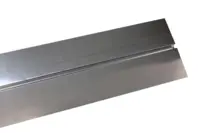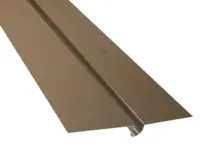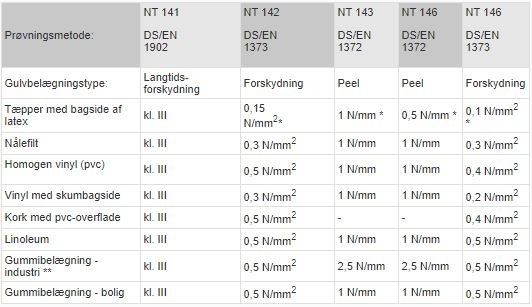- Forside
- Gode råd om gulv
- Konstruktioner
- Gulvlim
- Akustikpaneler
- Afpassede tæpper
- Bambusgulve
- Bordplader & bordben
- Designgulve
- Fliser og klinker
- BeefEater gasgrill
- Gode råd om gulv
- Gulvtæpper
- Gulvvarme
- Græstæpper
- Korkgulve
- Køkken, bad & garderobe
- Laminatgulve
- Linoleumsgulve
- Maling, Væv & Spartel
- Måtter
- Møbler & Boliginteriør
- Nålefilt og messetæpper
- Plejeprodukter
- Restpartier & gode tilbud
- Sildebensparket & Stavparket
- Tæppefliser
- Terrassebrædder
- Tilbehør
- Trægulve
- Vareprøver
- Vinylgulv
- Værktøj
- Øvrige produkter
- Loft- og vægpaneler
- Flotte gulve
- Fyrretræsgulv
- Klikgulve
- Bestilte varer
-
-26%
-
Populær29,00 DKK
-
29,00 DKK pr m2
-
Populær21,00 DKK
-
29,00 DKK pr m2
Gulvlim
Alle informationer på denne side er kopieret materiale fra Gulvfakta som er et fagteknisk opslagsmateriale, Kilde: Gulvfakta
2.2.0.1 Generelt
2.2.0.2 Limningsmetoder
2.2.0.3 Limning
2.2.0.4 Arbejdsmiljø
2.2.0.5 Klassificering af lim
Alle informationer på denne side er kopieret materiale fra Gulvfakta som er et fagteknisk opslagsmateriale, Kilde: Gulvfakta
2.2.0.1 Generelt
Limning anvendes for, at gulvbelægningen skal ligge fast mod undergulvet, så denne ikke forskydes eller buler op.
Limning har stor indflydelse på, hvordan en gulvbelægning er i stand til at modstå påvirkninger fx fra gående til rullende færdsel og/eller fra fugtbetingede bevægelser. En korrekt udført limning giver gulvet den længste levetid.
Gulvlime er speciallime, som er udviklet til bestemte formål. De fleste forhold ved anvendelse af gulvlime er meget ensartede, men der er forskelle. For at opnå et godt resultat skal der tages hensyn til både gulvbelægning og underlag.
Lim skal vælges i samråd med gulvleverandøren, så den passer til den aktuelle opgave dvs. gulvmateriale, underlag og belastning.
De fleste gulvlime er i dag vandbaserede, og de har som hovedregel først opnået deres styrke, når vandet er fordampet. Hvis gulvbelægningen er gennemtrængelig for vand, som fx i forbindelse med rengøring, skal både lim og underlag kunne tåle kortvarig fugtpåvirkning.
Til limning under vanskelige forhold kan der eventuelt anvendes 1- eller 2-komponent lime uden vand. Anvendelse af disse limtyper kan dog give en række arbejdsmiljømæssige problemer, idet bindemidlet som regel er baseret på polyuretan. I disse tilfælde skal Arbejdstilsynets regler følges.
For at opnå den bedst mulige vedhæftning foreskriver lim- og belægningsleverandør en limmængde pr. kvadratmeter. Limmængden er imidlertid kun retningsgivende, idet underlagets planhed og sugeevne har stor indflydelse på limbehovet.
Ud fra et teknisk synspunkt bør lime:
• Have tilstrækkelig styrke til at modstå de kræfter, som optræder i limfugen
• Kunne modstå fugtpåvirkning op til den fastsatte værdi
• Have evne til at stå i limstrenge, så der kan skabes kontakt mellem lim og gulvmateriale
• Have et lavt vandindhold for at undgå deformation af gulvmaterialerne på grund af ensidig vandpåvirkning på gulvbelægningens underside
• Ikke have generende afgasning til indeklimaet
• Til brug med visse gulvbelægninger være bestandig over for blødgørere
• Opfylde myndighedskrav til miljømærkning og sikkerhedsdatablade
• Have hurtig fiksering så belægningen fastholdes i limfugen
2.2.0.2 Limningsmetoder
Der er fire hovedtyper af limning:
• Vådlimning herunder sen vådlimning
• Hæftlimning
• Kontaktlimning
• Tørlimning
Vådlimning
Ved vådlimning bringes underlag og belægning i kontakt med hinanden så hurtigt efter limpåføringen, som det er muligt.
Fordelene ved vådlimning er, at der kan opnås god styrke, og at der kan ske justering af gulvbelægningen efter nedlægningen.
Spartling af underlag anvendes blandt andet for at opnå tilstrækkelig sugeevne for limen.
Vådlimning anvendes, hvor underlaget eller belægningen ofte er sugende og normalt til trægulve og elastiske gulvbelægninger.
Sen vådlimning
Visse gulvbelægningstyper kræver sen vådlimning for at undgå dimensionsændringer, som følge af fugtpåvirkning fra limen. Ved sen vådlimning forstås, at nedlægningen først foretages, når hovedparten af vandet er fordampet, men at der stadig er mulighed for at justere gulvbelægningen og samtidig opnå god styrke.
Sen vådlimning anvendes bl.a. til mindre sugende underlag eller til særlige situationer, som fx når vægge og lofter i laboratoriemiljøer skal beklædes med elastiske gulvbelægninger.
Hæftlimning
Ved hæftlimning bør kun anvendes egnede limtyper.
Ved hæftlimning bringes fladerne først i kontakt med hinanden, når limen har opnået "tape-effekt", som kontrolleres ved at trykke med en finger på limstrengen, der ikke må give afsmitning.
Hæftlimning anvendes primært, hvor hverken belægning eller underlag er sugende. Kontakten mellem materiale og lim bliver knapt så god, som den gør ved vådlimning. Justering af belægningen efter nedlægning er ikke mulig.
Hæftlimning anvendes normalt til tekstile gulvbelægninger, men anvendes også til visse typer elastiske gulvbelægninger som fx vinylfliser.
Kontaktlimning
Ved kontaktlimning påføres begge flader lim. Limen skal være tør, før fladerne bringes i kontakt med hinanden med størst muligt pres. Der er ikke mulighed for efterfølgende korrektion af gulvbelægningens placering på underlaget.
Kontaktlimning anvendes normalt kun, hvor andre muligheder for limning ikke kan benyttes.
Tørlimning
Tørlimning sker med folier med dobbeltsidet limlag.
Folier findes i forskellige bredder. Folier til fuldfladeklæbning på gulv er normalt fra 50-100 cm brede og strimler findes i forskellige bredder alt efter anvendelsesformål.
Strimler anvendes normalt til fodlister mv. men kan fx også, for nogens tilfælde, anvendes til klæbning af hulkehl i og uden for vådrum.
Der kan anvendes tørlimning på både sugende og ikke sugende underlag og det kræves normalt, at underlaget primes.
Tørlimning er kun egnet til tekstile og elastiske gulvbelægninger. Der er ingen tørretid, så gulvbelægningen er omgående klar til belastning og til eventuel svejse- og fugearbejde.
2.2.0.3 Limning
Ved limning skal limfladerne være rene, tørre og klæbebare. Leverandørens anvisninger om limforbrug, påføringsmetode mv. skal følges for at sikre et godt resultat.
Vær særligt opmærksom på, at du anvender den korrekte limspartel samt at nogle limspartler skal holdes lodret for at give den korrekte mængde lim, mens andre skal danne en vinkel på ca. 60º ift. gulvfladen, samt at din limspartel holdes ren og fri for gammel indtørret lim.
Ved limning på betonunderlag skal limen kunne modstå den resterende betonfugt, som er godkendt i forhold til den aktuelle gulvbelægningstype.
Visse limtyper kan også påføres med rulle eller limpistol / limmaskine.
Gulvbelægningstype Krav
Tekstil eller kvartsvinyl
Restbyggefugt højst 90 % RF
Elastiske fx linoleum, vinyl, LVT,
kork eller gummi Restbyggefugt højst 85 % RF
Trægulve
Restbyggefugt højst 65 % RF
Restbyggefugt > 65 % RF kontaktes limleverandøren
Tabel 1. Maksimal restbyggefugt i beton ved limning af forskellige gulvbelægningstyper.
Vær opmærksom på, at høje RF værdier - typisk over ca. 65 % RF - i ældre undergulve, kan skyldes udefrakommende fugt. Her bør leverandøren kontaktes.
Er betonens restbyggefugt højere end de maksimale fugtgrænser, må der ske en udtørring eller indbygges en effektiv fugtspærre mellem undergulv og gulvbelægning.
Som udgangspunkt kan det aldrig anbefales, at forsætte gulvarbejderne hvis fugtniveauerne er over kravene for, hvad limene midlertidigt kan modstå af restbyggefugt - uanset fugtspærremetode.
Under og efter limning af gulvbelægninger skal temperaturen i luft og undergulv være mellem 17 og 25º C og luftfugtigheden mellem 35 og 75 % RF, for trægulve dog mellem 30 og 65 % RF. Skal arbejdet udføres under andre klimatiske forhold, skal både limleverandør og gulvbelægningsleverandør tages med på råd, og deres anvisninger følges.
Underlaget skal være ensartet og plant for at sikre den bedst mulige vedhæftning og styrke mellem undergulv og gulvbelægning.
Stærkt sugende undergulve kan primes inden limning for at sikre en ensartet vedhæftning, i disse tilfælde bør limleverandøren kontaktes.
På gipsbaserede undergulve som fx Anhydrit, skal der anvendes en primer, som ud over at sikre god vedhæftning også kan forhindre, at fugten i limen skader underlaget.
Gulvbelægninger fuldlimes til undergulvet med en lim efter gulvbelægningsleverandørens anvisning. Efter lægningen bør der ikke være færdsel på gulvet ud over almindelig gangtrafik, før limen er hærdet.
Al anden belastning på gulvet, fx fra rullestilladser, transportvogne, møbler eller andre punktbelastninger og lignende, må tidligst ske, når limen har opnået fuld styrke.
Afhængigt af rummets temperatur og luftfugtighed tager dette mindst 8 døgn, men der kan gå op til 14 døgn, før fuld limstyrke opnås.
Fuger i vinyl må ikke svejses, og linoleum og gummi må ikke trådfuges, før limen har opnået tilstrækkelig styrke. Hvis der limes på et trinlyddæmpende underlag som korkment eller lignende, kan hærdetiden blive væsentligt forlænget.
2.2.0.4 Arbejdsmiljø
Gulvlime skal mærkes med MAL-kode, der er udtryk for hvilke forholdsregler, der skal træffes, når der arbejdes med limen. Hvis der findes en lim med lavere MAL-kode end det oprindelige produkt og de ønskede tekniske egenskaber er tilstede, skal denne vælges.
Sikkerhedsdatablad fra leverandøren skal være på brugsstedet. Læs specielt punkterne om værnemidler, anvendelsesbegrænsninger og eventuelle uddannelseskrav grundigt igennem.
Limleverandøren bør altid kontaktes, hvis der er tvivl.
2.2.0.5 Klassificering af lim
Gulvbranchens limleverandører skal overholde nedenstående minimumskrav:
• Forskydningsstyrke
• Langtids forskydningsstyrke
• Peel-styrke
• Blødgørebestandighed
I tabel 2 ses de grænse- / minimumsværdier limene skal overholde for at kunne opnå klassificeringen. Dokumentationen sker ved, at fremlægge prøvningsresultater som viser, at limen overholder fastsatte kriterier.
Til prøvningen anvendes Nordtestmetoderne NT 141, NT 142, NT 143 og NT 146 eller DS/EN 1902, DS/EN 1372 og DS/EN 1373
Tabel 2. Grundlag for Gulvbranchens klassificering af gulvlime til vådlimning.
* Eller 100 % tæppebrud.
** Tung belastning og evt. stor vandbelastning.
















